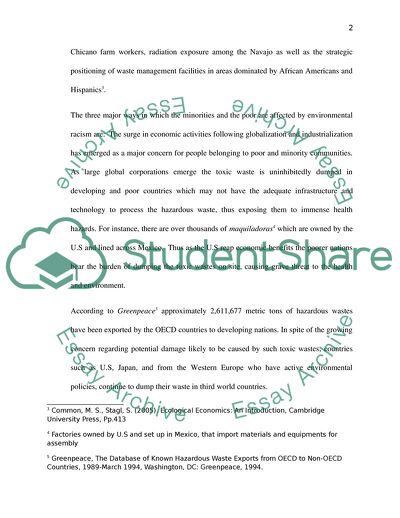
- Home
- Free Samples
- Premium Essays
- Editing Services
- Extra Tools
- Essay Writing Help
- About Us
- Studentshare
- Subjects
- Miscellaneous
- Race and Ethnic Relations- Final
Race and Ethnic Relations- Final - Essay Example

- Subject: Miscellaneous
- Type: Essay
- Level: Masters
- Pages: 4 (1000 words)
- Downloads: 0
- Author: albertobosco
Extract of sample "Race and Ethnic Relations- Final"
r toxic and hazardous waste facilities; the official sanctioning of the life-threatening presence of poisons and pollutants in our communities; and the history of excluding people of colour from the leadership of the environmental movement”2 Research Findings suggest that race consistently emerges as the sole factor that influences the location of commercial hazardous facilities in areas predominantly occupied by minority communities. Various studies conducted in the mid nineties, documented this alarming trend which lead to major revelations such as specific exposure to air pollution and lead among the urban African Americans, pesticide contamination for Chicano farm workers, radiation exposure among the Navajo as well as the strategic positioning of waste management facilities in areas dominated by African Americans and Hispanics3.
The three major ways in which the minorities and the poor are affected by environmental racism are: The surge in economic activities following globalization and industrialization has emerged as a major concern for people belonging to poor and minority communities. As large global corporations emerge the toxic waste is uninhibitedly dumped in developing and poor countries which may not have the adequate infrastructure and technology to process the hazardous waste, thus exposing them to immense health hazards.
For instance, there are over thousands of maquiladoras4 which are owned by the U.S and lined across Mexico. Thus as the U.S reap economic benefits the poorer nations bear the burden of dumping the toxic wastes on site, causing grave threat to the health and environment. According to Greenpeace5 approximately 2,611,677 metric tons of hazardous wastes have been exported by the OECD countries to developing nations. In spite of the growing concern regarding potential damage likely to be caused by such toxic wastes, countries such as U.
S, Japan, and from the Western Europe who have active environmental policies, continue to dump
...Download file to see next pages Read MoreCHECK THESE SAMPLES OF Race and Ethnic Relations- Final
Ethnic and Cultural Diversity in Families
Race as a Social Construction
Business Ethics
Racial Hostility within the Media in the US
Racial and Ethnic Differences: African Americans
Racial Relations in the US Today
Role of Medicine and Health in Relation to Ethics
The Social and Cultural Diversity

- TERMS & CONDITIONS
- PRIVACY POLICY
- COOKIES POLICY